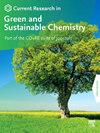Sustainable extraction of bioproducts from cactus pear waste: Economic viability and market opportunities in a green economy
Q2 Materials Science
Current Research in Green and Sustainable Chemistry
Pub Date : 2025-01-01
DOI:10.1016/j.crgsc.2025.100449
引用次数: 0
Abstract
This study investigates the economic viability of extracting bioproducts from discarded cactus pear (Opuntia ficus-indica) waste in Sicily, where the cactus pear industry is well-established. The focus is on employing green extraction technologies, such as microwave-assisted methods, to produce valuable compounds like seed oil, pectin, and bioactive substances for use in the cosmetic, nutraceutical, and pharmaceutical industries. The results demonstrate that increasing the scale of production from 200 to 400 tons significantly enhances the financial performance of the operation, reducing the payback period from 6.5 to 4 years and yielding positive Net Present Value (NPV) and Internal Rate of Return (IRR) values, reaching up to 35.7 %. However, challenges such as the seasonality of raw material availability and the high energy requirements of green technologies are noted. These findings suggest that while the project is economically feasible, managing supply chain variability and optimising energy consumption are critical for long-term sustainability. Additionally, the increasing consumer demand for sustainable and functional products provides a strong market opportunity for these bioproducts, though competition from international players leveraging economies of scale could pose a threat. This study highlights the importance of integrating green technologies in bioeconomy projects and offers insights for policymakers and industry leaders. Policymakers can support these initiatives through incentives and regulations, while businesses in the cosmetic and nutraceutical sectors may find competitive advantages in the quality and sustainability of these bioproducts. Further research should explore alternative biomass sources and innovations in extraction efficiency to ensure continuous production and cost reductions.
从仙人掌梨废料中可持续提取生物产品:绿色经济中的经济可行性和市场机会
本研究调查了西西里岛从废弃仙人掌梨(Opuntia ficus-indica)废物中提取生物制品的经济可行性,西西里岛的仙人掌梨产业已经建立。重点是采用绿色提取技术,如微波辅助方法,生产有价值的化合物,如种子油、果胶和生物活性物质,用于化妆品、营养食品和制药行业。结果表明,将生产规模从200吨增加到400吨,显著提高了经营财务绩效,投资回收期从6.5年缩短到4年,净现值(NPV)和内部收益率(IRR)均为正,达到35.7%。然而,也注意到诸如原材料供应的季节性和绿色技术的高能源需求等挑战。这些发现表明,虽然该项目在经济上是可行的,但管理供应链的可变性和优化能源消耗对长期可持续性至关重要。此外,消费者对可持续和功能性产品的需求不断增长,为这些生物产品提供了强大的市场机会,尽管来自国际参与者利用规模经济的竞争可能构成威胁。这项研究强调了在生物经济项目中整合绿色技术的重要性,并为政策制定者和行业领导者提供了见解。决策者可以通过激励和法规来支持这些举措,而化妆品和营养保健品行业的企业可能会在这些生物产品的质量和可持续性方面找到竞争优势。进一步的研究应探索替代生物质资源和提取效率的创新,以确保持续生产和降低成本。
本文章由计算机程序翻译,如有差异,请以英文原文为准。
求助全文
约1分钟内获得全文
求助全文
来源期刊

Current Research in Green and Sustainable Chemistry
Materials Science-Materials Chemistry
CiteScore
11.20
自引率
0.00%
发文量
116
审稿时长
78 days
 求助内容:
求助内容: 应助结果提醒方式:
应助结果提醒方式:


